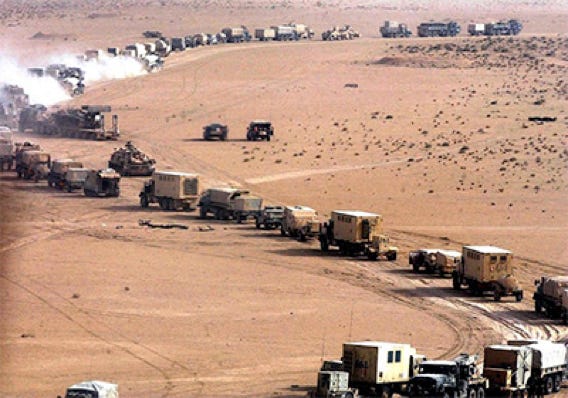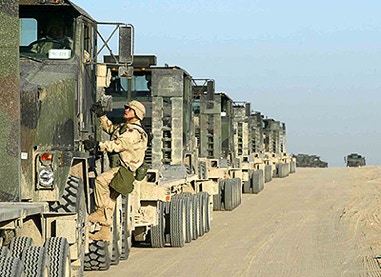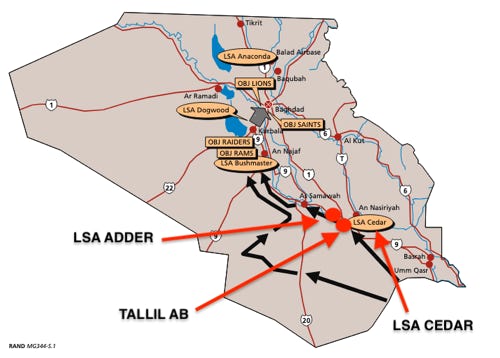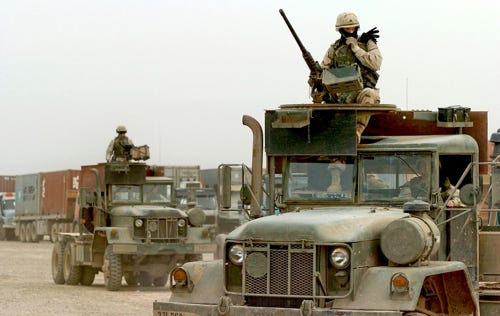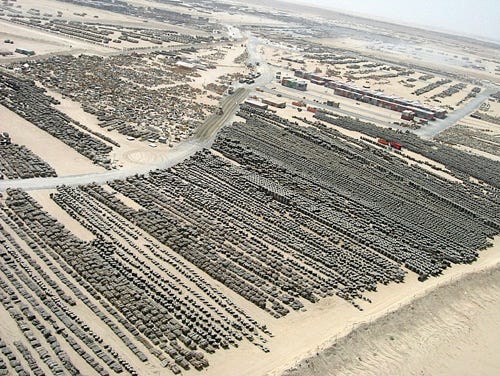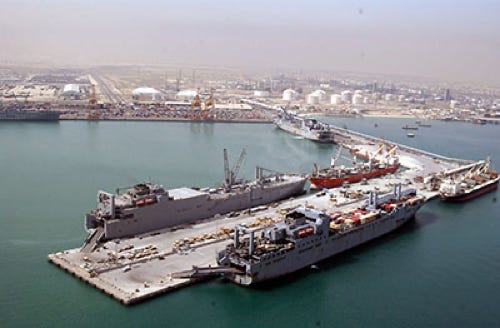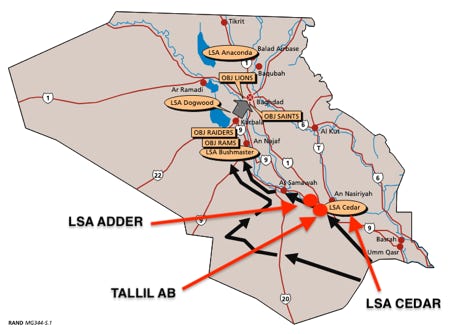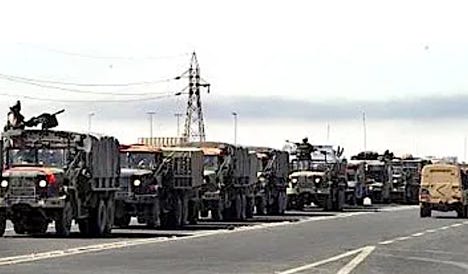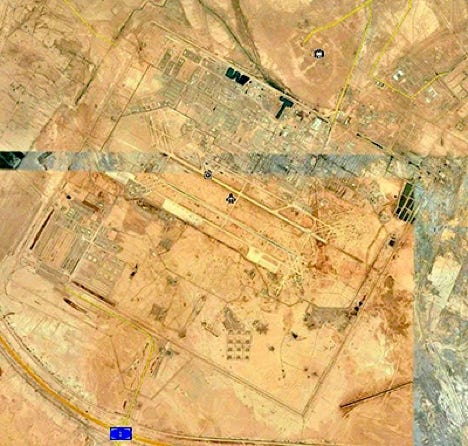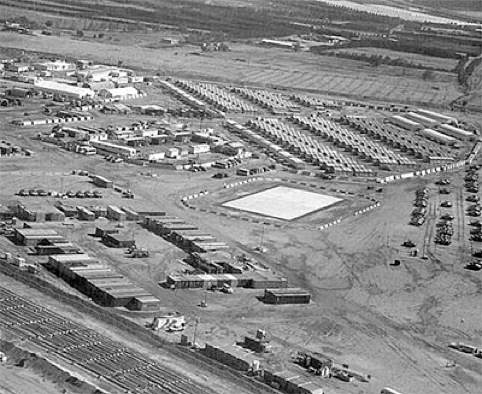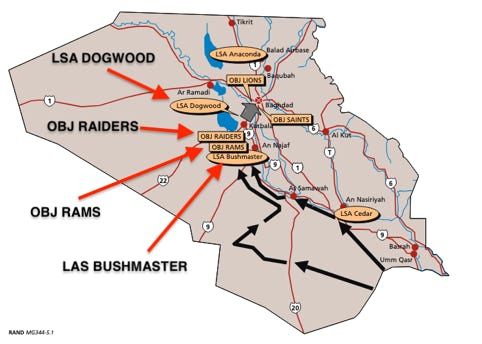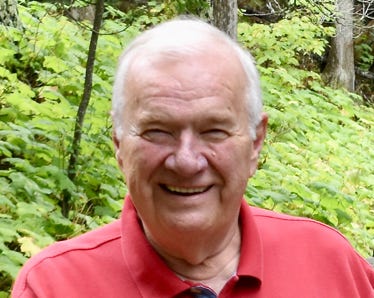Talking Proud: Service & Sacrifice
Logistics in the Iraq War: “A Herculean feat”
“Good generals study tactics. Great generals study logistics”
Let’s get real: 6th Transportation Battalion
“Every truck has a personality! I want mine!”
Those were the plans.
All hands understood the logistics tail was going to be long and that it would get longer the farther north the combat forces moved. Furthermore, the Army had planned to use only one main supply line, figuring that the geography favored the advance force as they could avoid towns and cities. In turn, this allowed the supply line to run through the desert areas to the west of the Euphrates. On the downside, commanders took everything they could with them, which lengthened the convoy tails traveling with the combat force. Quite often, the roads would get choked. Most of the time, MPs were not with the forward forces and therefore could not clear up the choke points.
The 3rd ID, Major General Buford C. Blount III in command, was V Corp's principal combat force tasked to run up to Baghdad.
The 3rd ID consisted of three brigades, two brigades each consisting of two infantry regiments, one armor regiment, and one artillery regiment. The other brigade had one cavalry, one infantry, two armor, and one artillery regiment, roughly 18,000 members in all.
To add context, a Congressional Research Service (CRS) report lays out the number of soldiers involved in OIF. It said about 200,000 troops were in Iraq or surrounding areas, of which about 160,000 were inside Iraq. Overall, the Army’s regular and National Guard forces numbered about 113,000.
The 3rd ID crossed the line of departure with only five days supply of food and water in all units, with an additional two days in the support battalions. I have read, however, that since the order to cross the line came one day early, the 3rd ID left with only three days supplies.
The 3rd ID chose to have its supplies positioned forward in the theater rather than in the US. Therefore, each of the 3rd ID's three Brigade Combat Teams (BCTs) drew on prepositioned brigade sets, known as Authorized Stockage Lists (ASLs). The 3rd ID built its ASLs based on lessons learned during exercises and their needs at Ft. Stewart, Georgia, its home station..
A problem arose in part because the 3rd ID used up its supplies at war in OIF far faster than in exercises. Because of its rapidly developing combat needs, the 3rd ID had to send its requests for supplies to the national supply base in the US, which meant a long wait. This problem became more complex because the ASLs developed at home did not use the same methodology as the prepositioned ASLs.
My reading of the impact is that the combat and support forces had to make many adjustments on the run. And adjust they did. A major strength of the US Armed Forces throughout their history has been their ability to innovate on the go, and most certainly, all involved in OIF did just that.
I have chosen to highlight the 6th Transportation Battalion (BN) (Motor) as an example of what happened in the real world. The 6th was tasked to function as a truck battalion to support the 3rd ID. Its first logistics objective was to take control of LSA CEDAR and set up LSA ADDER, both near Tallil Airport.
The 6th BN was composed of six companies and two Movement Control Teams. Three of its companies were maritime associated. It was told to operate as a truck battalion, so it sent its 89th Medium Truck Company and its 551st Cargo Transfer Company to Kuwait.
The 6th planned to go to the theater by ship, but in January 2003, the order came down to move out by air. Its 89th Medium Truck Co. left by air on January 6, 2003. So far, so good. However, its C-5 transport aircraft went down for parts in Moron, Spain, and the 6th sat there for five days waiting for aircraft parts, diplomatic clearance, runway space, and, of all things, USAF C-5 flight crews. The troops waited in the hangar.
The 89th arrived in Kuwait City on January 13, a week after departing by air. The rest arrived on January 14. Its headquarters detachment and Advanced Echelon (ADVON) deployed from Kuwait City to the Camp Arifjan forward logistics base a bit south of Kuwait City. They found that facilities had not yet been completed there, so they set up in a vacant warehouse. The ADVON looked around for a different location away from Camp Arifjan and built a tent city. Two weeks later, it had to move to a new location close to Camp Arjifan.
Three days after arriving, the battalion began convoy operations within Kuwait. It spent its first month in the theater as the only line-haul company available. It moved most of the theater containers, including Army and Marine Corps, and delivered ammunition to storage points. This was a massive logistics endeavor.
Next, the 89th was tasked with operating as the Port Support Activity (PSA) and driving everything off the arriving vessels. Most combatants arrived by air, and the 89th had to get them and their equipment into their crossing positions, including the Brits. The 6th spent 85 days moving Army, Marine Corps, and British units to their positions.
The 6th BN was then reconfigured to include three more truck companies under its command: one each Pallet Loading System, Medium Truck, and Heavy Equipment Truck. Lt. Col. Jeffrey Hemlock, USA, was in command.
The 6th’s next step was to prepare to cross the line of departure. As always, senior non-commissioned officers (NCOs) were sent out to “requisition” equipment to enhance the troops' lives. According to the battalion's history, the battalion signed for “one of four mobile kitchens, government rations, 73 Temper tents, 100 to 200 showers, four Mobile Kitchen Trailers, plastic toilets and other comforts for life support. "
Three logistics packages, ADDER 1, 2, and 3, were organized to cross the berm. The 6th BN joined ADDER 2 with other units.
The 3rd ID, Marines, and British passed through the berm on March 19, 2003, and then moved directly to Nasiriyah.
Three days later, on the morning of March 22, 2003, the 6th Transport Battalion crossed into Iraq. As planned, it followed in trail formation behind the 3rd ID. It was tasked with establishing LSA CEDAR at the Tallil Air Base (AB) outside Nasiriyah and then setting up Logistics Supply Area (LSA) ADDER near An Nasiriyah and Tallil Airport.
Seizing the airport was a big deal. The US urgently needed this base. It is situated on the outskirts of An Nasiriyah, only about 180 miles southeast of Baghdad. It was an ideal location for fighter and transport aircraft in these initial days. An Army War College paper said that Tallil was envisioned as a main logistics and aviation hub for the march to Baghdad.
After crossing into Iraq on March 22, the 6th BN’s convoy reached Route 1, a six-lane highway. All lanes were crammed with traffic belonging to the combat units. The 6th arrived at Fire Support Base CEDAR in the late afternoon of March 22. The convoy had spread out, so it took much of the night for all the vehicles to close. The drivers pulled guard duty.
When the 6th BN’s troops woke up on March 23, they moved toward Tallil Airport, which was to be LSA CEDAR. The 3rd ID had already moved northward past the airport.
The 3rd ID seized some bridges to and from Nasiriyah, handed the city to Marine Corps Task Force Tarawa on March 23, and moved northward. The TF encountered what one general termed a “a damned tough fight.”
In the meantime, however, Lt. Col. Hemlock and his general went to Tallil on the morning of March 23 and arrived while fighting was still happening. The airport was in desperate shape. The Allies had bombed it to smithereens during the first Iraq War, and it was a wasteland. However, it was served by two main runways and could support two fighter squadrons with support units. The runway was littered with obstacles, and engineers would have to clear it.
Hemlock sent a team to the airport to set up air terminal operations. A USAF special tactics team (STT) and tanker airlift control element (TALCE) arrived at Tallil on March 23. Together, these teams had pararescue specialists, combat controllers, combat weather personnel, tactical air control parties, deployed maintenance, and aerial port functions. Civil Engineers arrived to clear the runway, which took until March 25.
Hemlock concluded that the 6th BN could not mix its trucks with all the activity at the airport. The plan specified that LSA CEDAR would be situated at the airport, but the 6th BN opted for a nearby location for LSA CEDAR where they would put their trucks. They established a Trailer Transfer Point (TTP) at the new CEDAR location.
On March 25, the 6th began running convoys from LSA CEDAR to the 106th Transportation Battalion’s logistic base at NAVISTAR in Kuwait to pick up their loads. The plan was to pick up cargo at NAVISTAR and deliver it to the 3rd ID combatants near LSA BUSHMASTER, near An Najaf, about 140 miles to the northwest.
But first, the 3rd ID had to get to Objective RAMS near An Najaf and enable the establishment of LSA BUSHMASTER. This LSA was mission essential. It was needed before the 3rd ID could go through the Karbala Gap. Once BUSHMASTER was secured, a logistics buildup got underway. Outfits like the 6th BN could now run down to NAVISTAR in Kuwait, pick up their loads, and move tons of supplies to BUSHMASTER for storage.
The 2nd Brigade (BDE) of the 3rd ID was tasked to get to Objective RAMS, a desert area southwest of Najaf. The 2nd BDE had to secure it and enable the setup of LSA BUSHMASTER a bit south of An Najaf. It achieved its objective on March 23.
In the meantime, the 1st BDE went up to Objective RAIDERS to the north. The 3rd BDE was forced to remain in As Samawah because of unexpected heavy resistance and the need to cover the 3rd ID’s rear.
LSA Bushmaster and LSA Dogwood, located north of the Karbala Gap, were to provide combat units with robust supplies for the advance on Baghdad.
It is now March 25, and this was the first major sustainment push for the 3rd ID since it left Iraq on March 19. Logistics units that left on March 23 did not get to BUSHMASTER until March 26, when their loads had to be distributed. This delivery effort provided two days of supplies. Another delivery was on its way for March 27. Logistics units were then scheduled to run to NAVISTAR every other day.
The plan was to replenish the 3rd ID units back to the five-day supply level with which they began, but the logistic flows could barely replenish them to 1+ days of supply. Thus, the 3rd ID was in a “supply pickle.”
In many cases, the maneuver units were operating at subsistence levels compared to what they had when they started. Food supplies fared better than water, but food and spare parts were huge worries. The supply of ammunition was more difficult since the troops used their ammunition at the time of need and in the quantities needed.
Another issue to arise was a shortage of trucks. The inventory was built up, but RAND Corp. pointed out that truck capacity was inadequate,
“Inadequate truck capacity resulted from problems on the supply and demand side of the equation. On the one hand, fewer trucks were provided than were requested, arrived later than needed, or had their performance curtailed by external factors. On the other hand, unexpected requirements drove up the need for trucks.”
Additionally, the quality of roads analyzed by intelligence was worse than assessed. Furthermore, unexpected resistance forced supply trucks to go off-road. Enemy action caused convoys to stop, and some drivers stopped without coordinating the stop. Some even fell asleep at the wheel. Furthermore, the decisions to use bottled water and transport troops placed unanticipated demands on truck transport.
One more note on BUSHMASTER. Once up and running, support, supply, and engineering battalions coming up the 3rd ID's rear had to bring in tons of supplies to be stored there. They did this in a few days. As an aside, the troops "requisitioned" bulldozers and dump trucks from a nearby cement factory and dug and transported clay to a location where the 94th Engineering Battalion was constructing an airstrip. Then the 535th Combat Support Co. troops mixed the clay and the quick drying composite, laid it down in a 3,500 ft. runway, and stood ready to accept C-130 transports in and out.
On March 24, a massive dust storm, heavy rain, strong winds, and limited visibility began, causing the V Corps to stop before entering the Karbala Gap. The weather was a major factor. An operational pause had already been planned to enable logistics units to catch up with the combatant forces. The foul weather was used to refit, refuel, and reassess the plan for entering Baghdad.
An important decision was made on the 3rd ID. A brigade combat team of the 82nd ABN and the 101st ABN were given to V Corps, and they relieved the division’s 3 BDE back in As Samaweh. This enabled the 3 BDE to rejoin the other two brigades north of An Najaf.
I have three more items of business before moving to the next section.
On March 23, 2003, the Marine TF Tarawa was approaching Nasiriyah and came upon a US Army convoy coming out of the city toward it. An Army sergeant told the Marines that the 507th Maintenance Company had accidentally driven into the city instead of going around and was separated from the main convoy. The sequence of events that followed is jolting. My take is the 507th troops involved came under heavy enemy fire from Fedayeen militia. Their weapons, a .50 caliber machine gun, M-16 rifles, and M-249 light machine guns, malfunctioned or misfired on multiple occasions. Eleven soldiers were killed, and seven were taken prisoner.
One of those taken prisoner was PFC Jessica Lynch, a supply clerk. You may recall her from the news. She and the other survivors of the attack were taken to a hospital in Nasiriyah. One of them died in hospital. On April 1, a SOF team entered the hospital and rescued Lynch and recovered eight bodies of American soldiers. The other POWs were recovered alive later in April.
This experience had an impact. The US leadership had to evaluate the impact such attacks might have on their supporting logistics convoys. The forces to the rear of the 3rd ID were a real concern.
The second item of business is to close the loop on Tallil. TF Tarawa’s fight to control An Nasiriyah took much longer than expected, until April 2. Nonetheless, on March 27, less than a week after capture, C-130 transports began using the airport. Land convoys and C-130 Hercules aircraft got equipment and materials to the base. The transports also flew in a brigade of combat troops. Army, Marine, and British engineers helped airmen build revetments for aircraft and refueling points.
The first A-10 Warthog air-to-ground fighter flew to Tallil on or about March 27 to refuel. One source said A-10s began operating from the field on or about March 31- April 1, while another said April 4, 2003. Whatever the case, this was a huge advantage, as the A-10s would be able to support the run against Baghdad directly from Tallil. Amidst all this, fighting continued at nearby An Nasiriyah, about 10 miles away.
On a lighter and less complex note, the 6th BN loaned a 96th Heavy Equipment Transportation Co. platoon to haul heavy engineering equipment belonging to the 101st ABN. The platoon did such a good job that the 101st held on to it and denied having it on loan. Then, the 6th Battalion reported the platoon missing in action, and the 101st had to admit the platoon was with it. It was returned to the 6th.
By March 25, the 3rd ID passed by the cities of An Nasiriyah, As Samawah, An Najaf, and Ad Diwaniyah. Its next stop was the Karbala Gap.
Battlefield Dynamism: As Samawah
Click to zoom graphic-photo
